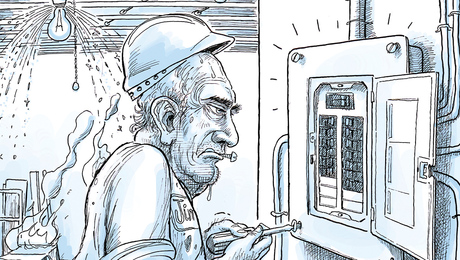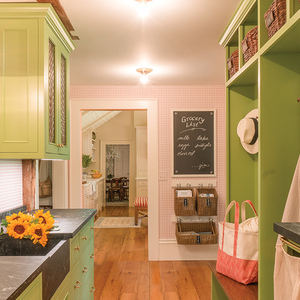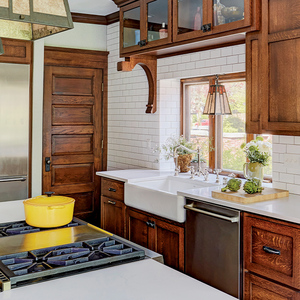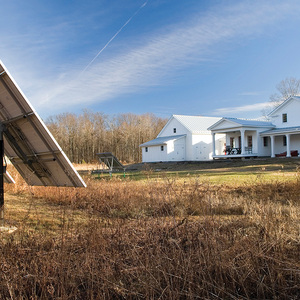I have a structural engineer who refuses to understand the strength of a traditionally framed hip roof. He insists that the hip needs to be calculated to support the loads as if it were a volume ceiling. ( no ceiling joists.) He says the roof diaphram, ceiling joists, collar ties etc. have no bearing on the calculations. Can anyone help me straighten him out with reference books (he’s a numbers guy)???
Discussion Forum
Discussion Forum
Up Next
Video Shorts
Featured Story

Dangerous electrical work and widespread misconceptions cause fires, deaths, and $1.5 billion in property damage annually.
Featured Video
Builder’s Advocate: An Interview With ViewrailHighlights
"I have learned so much thanks to the searchable articles on the FHB website. I can confidently say that I expect to be a life-long subscriber." - M.K.
Fine Homebuilding Magazine
- Home Group
- Antique Trader
- Arts & Crafts Homes
- Bank Note Reporter
- Cabin Life
- Cuisine at Home
- Fine Gardening
- Fine Woodworking
- Green Building Advisor
- Garden Gate
- Horticulture
- Keep Craft Alive
- Log Home Living
- Military Trader/Vehicles
- Numismatic News
- Numismaster
- Old Cars Weekly
- Old House Journal
- Period Homes
- Popular Woodworking
- Script
- ShopNotes
- Sports Collectors Digest
- Threads
- Timber Home Living
- Traditional Building
- Woodsmith
- World Coin News
- Writer's Digest


















Replies
Well, if there are no ceiling joists or rafter ties, he is right, AFAIK
Welcome to the
Taunton University of Knowledge FHB Campus at Breaktime.
where ...
Excellence is its own reward!
LOL.... that's a tall order bubba. I don't even argue with my own structural engineer(s) anymore and you want me to argue with yours? :) Frame it like he says or find another engineer is my advice. He's the one with the stamp, after all.
i think he is right too, think about what he is saying.
the hip needs to be calculated to support the loads as if it were a volume ceiling.
all of the jack rafters that attatch to the hip rafter at the top are being carried by the hip rafter. they are locked in place to some degree by the opposing jack rafters in much the same way that commons oppose each other and do not require a structural ridge, but the hip is different and will carry some load unlike the ridge in a non structural appliication which just prevents side motion, ie: a block
some of that load will be transferred down to wall at the bottom of the hip rafter, and some to the ridge, the hip is definitely carrying a load, and so is the ridge now that its a hip roof, it is carrying what has been transferred by the hip rafter. its not just a frieze block anymore, its holding up some weight.
when you say your engineer refuses to understand the strength of a hip roof what is it you want to do? what does the engineer want you to do?
you should be able to build a self supporting hip roof without joists or collar ties but the design, members, connections, etc will need to be engineered in that you have to run calculations to ensure it/they are strong enough/sized correctly, and you will have outward thrust if it is wrong. you don't want it to sag do you?
Find a new engineer.
Bob's next test date: 12/10/07
There is an article on hip roofs by a structural engineer in the May, 1994 issue of JLC: "Straight Talk About Hip and Valley Rafters," by Robert Randall. It's available for a few bucks on their site.
You may be disappointed in what he has to say; his recommendations are pretty conservative.
hip roof engineering
I've worked on homes 120 + years old with 1x6 hips and no sign of bracing or king posts and no sign of failure either. With ceiling joists properly in place the roof is supported by the fact that it is made up of 4 triangles. (1)The end roof is a triangle with the outside wall plates making the base of the triangle and the two hips making the legs. (2&3) The front and back roofs from the end of the ridge (first common rafters) to the outside wall corners where the hips are seated each make up a triangle with the front and back wall plates making the bases for right triangles with each hip being the hypoteneus and the first common rafter being the remaining leg. (4) The first common rafters at the juncture of the hips and the ridge (@ opposite sides of the ridge) make up the legs of the 4th triangle with the ceiling joists making up the base (assuming the joists connect to the two commons at the base and are properly tied togetther at any overlapping joints in the middle of the span). Finally the jack rafters and roof sheathing work together to create a single trianglular diaphragm that keeps the hips and walls straight. Triangle #4's base (the tying ceiling joists) is in tension preventing the front and back walls from splaying. The hips are shared by triangles #1,2,&3 and are further tied together via the jack rafters and the sheathing. Therefore, the end wall and the front and back walls can not splay nor can the wall corners come apart without stretching the hip and tearing apart all the connections between the jack rafters and the sheathing.
When you remove the ceiling joists then the dynamics require accounting for the loss of the fourth triangle. If the room is square and there is no ridge all 4 hips come together at the same place at the top. You have created a pyramid. It can not come down unless the connections throughout the system fail (see the last 2 sentences of previous paragraph). If the room is rectangular and there is a ridge and no ceiling joists, then to account for the loss of the (2) 4th triangles you need to design the ridge to be structural to carry the roof load in the same manner that you would for an open vaulted gable roof so that the wall sections parallel to the ridge don't splay and the ridge sag. The 4 hips and their connections must now transmit he ridge reactions to the outside corners where the rafters seat. Think of a child's swing set with "A" frames at each end of the center pipe that holds the swings. The "A"s are splayed out just like your hips and angled toward the pole which is like the ridge. The legs of the "A"s are usually buried in the ground or in concrete primarily to prevent the apparatus from tipping over from the forces created by a swinging load, but also to complete the bases of the traingles. Often the "A" will have a horizontal cross bar tying the legs together and completing the triangle as well. Discounting the swinging action for a moment and considering only static loads on the pole the reactions at the ends of the pole are carried by the four legs of the "A" frames. Likewise the reactions at the end of our ridge is carrie by the hip structure. It is important to note that the "A" created by our hips with its jack rafters and sheathing is acting like a single unit when it is properly connected. The front and back walls can't splay because the end hip sections would have to tear loose from the wall plates and all the sheathing on the front and back walls which is all acting in tension in relationship to the hips.
dw
Could you possibly simplify your description just a bit.
Are you arguiing that the size of the hip makes no difference in the above? I apologise , but am lost in the translation.